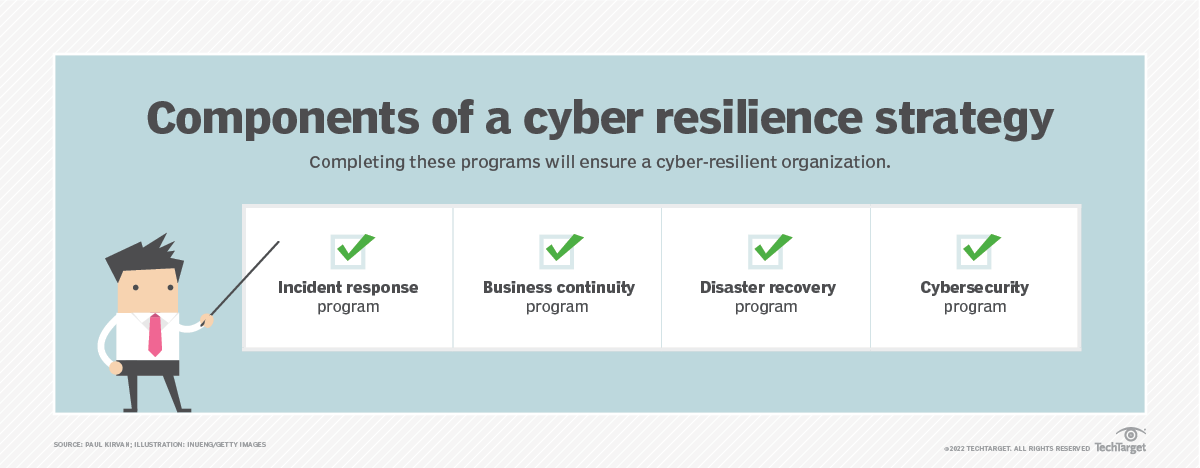It’s safe to say that all organizations in any industry can be the target of a cyberattack. These attacks can even force the largest multinational corporations to halt operations; lose billions in fines, legal fees, and business revenue; and face irreparable damage to brand reputation. To protect your business, you need a robust cyber resilience strategy with comprehensive measures to proactively safeguard your operations, mitigate risks, and bounce back from cyber incidents with strength.
Cybercrime is the biggest threat to businesses of all sizes. In less than a year, Between November 2021 and October 2022—less than a year—nearly 16 thousand cyber crimes were detected worldwide, and many more likely went unnoticed. It’s not a question of if, but when your organization will face a cyber threat.
Being prepared with a well-crafted cyber resilience strategy can mean the difference between swift recovery and irreparable damage. In this post, we’ll explore what a cyber resilience strategy is, its goals, and its benefits and provide ten actionable tips to help create a winning strategy for your organization.
What is a cyber resilience strategy, and why do you need one?
A cyber resilience strategy is a comprehensive plan encompassing the essential measures to identify, respond to, and recover from cyber threats. It considers the broader context of cybersecurity, aligning with your organization’s objectives, risk tolerance, and regulatory requirements. It goes beyond a cyber resilience framework by providing a strategic approach to establish resilience against cyberattacks.
But, the question arises: why does your organization need a cyber resilience strategy? The answer lies in the ever-evolving nature of the threat landscape. Cybercriminals constantly devise novel techniques to breach your defenses, exploit vulnerabilities, and disrupt operations. A cyber resilience strategy prepares you to confront these threats proactively, ensuring the seamless continuity of your business and mitigating potential harm.

The 5 Goals of a Cyber Resilience Strategy
An effectivecyber resilience strategy should be able to achieve most, if not all, of these five goals:
1. Prevent Threats
Proactively identify and mitigate cyber threats before the vulnerabilities in your system become compromised
2. Develop an Incident Response Plan
Establish a clear plan to detect, contain, and manage cyber incidents swiftly and effectively.
3. Maintain Business Continuity
Ensure regular operations continue uninterrupted, even in the face of a cyberattack, by implementing fast and effective backup and recovery measures.
4. Secure Stakeholder Confidence
Instill trust and confidence in your customers, partners, and stakeholders by demonstrating your commitment to cybersecurity and resilience.
5. Comply With Industry Regulations
Your strategy should help you maintain compliance with industry regulations and standards, to protect your stakeholders’ sensitive data and against legal and financial consequences.
The Benefits of a Cyber Resilience Strategy
Building a powerful cyber resilience strategy to guide your organization offers many benefits, including:
- Enhanced Security – Strengthens your organization’s overall security by identifying and addressing vulnerabilities, bolstering protection against potential cyber threats.
- Business Continuity – Ensures uninterrupted operations by minimizing the impact of cyber incidents, safeguarding financial stability, and maintaining seamless workflow.
- Reputation Protection – Safeguards your organization’s reputation and foster trust among customers and stakeholders, reinforcing your commitment to cybersecurity and resilience.
- Competitive Edge – Gains a competitive advantage by demonstrating your dedication to robust cybersecurity practices, positioning your organization as a trusted and reliable partner.
- Regulatory Compliance – Ensures adherence to industry regulations and standards, avoiding potential penalties and legal complexities arising from non-compliance.
- Adaptability to Emerging Threats – Continuously evaluate and evolve your strategy to proactively address new and evolving cyber threats, staying one step ahead in an ever-changing digital landscape.

10 Tips for Creating a Cyber Resilience Strategy
Now that you have a solid understanding of the importance of a cyber resilience strategy, let’s dive into actionable tips that can help you create an effective and proactive plan:
1. Assess and Identify
Start by conducting a thorough assessment of your organization’s cybersecurity posture. Identify potential vulnerabilities and risks across your systems, networks, and data infrastructure. This assessment forms the basis for developing a targeted and successful cyber resilience strategy.
2. Develop an Incident Response Plan
Craft a detailed incident response plan that outlines clear procedures to follow in the event of a cyber incident. This plan should encompass incident detection, containment, recovery, and communication. Regularly test and update your plan to ensure its effectiveness in real-world scenarios.
3. Prioritize Employee Training
Your employees are your first line of defense against cyber threats. Implement a robust cybersecurity awareness training program like CybeReady that educates your staff on best practices, common attack vectors, and how to identify and respond to potential threats. Make cybersecurity training a regular part of employee onboarding and provide ongoing refresher courses to reinforce knowledge.

4. Regularly Test and Evaluate
Cyber threats and vulnerabilities are ever-evolving. Regularly test and evaluate your systems, processes, and security controls to identify weaknesses and gaps. Conduct vulnerability assessments, penetration testing, and security audits to proactively address vulnerabilities before attackers can exploit them.
5. Foster Partnerships and Collaboration
Cyber resilience necessitates collaborative efforts. Engage with industry experts, participate in cybersecurity forums, and establish partnerships with trusted allies to exchange knowledge, insights, and best practices. By leveraging the expertise of others, you can enhance your cyber resilience capabilities and stay ahead of emerging threats.
6. Implement Encryption and Data Protection
Safeguarding sensitive data is of utmost importance in a cyber resilience strategy. Deploy robust encryption measures to protect data at rest and in transit. Establish stringent access controls, authentication protocols, and data classification frameworks to ensure critical information’s confidentiality, integrity, and availability.
7. Establish a Robust Backup and Recovery Strategy
Prepare for worst-case scenarios by developing a comprehensive strategy for backing up and recovering data. Regularly back up critical data and systems and conduct tests to ensure the effectiveness of the restoration process. Consider utilizing off-site backups or cloud-based solutions to enhance redundancy and resilience.
8. Continuously Monitor for Threats
Employ real-time monitoring systems that provide visibility into your network, systems, and applications. Utilize intrusion detection systems, security information and event management (SIEM) tools, and log analysis to detect and respond to cyber threats promptly. Proactive monitoring enables early detection and swift mitigation of potential security incidents.


9. Stay Informed
Stay current with cybersecurity trends, emerging threats, and regulatory changes. Subscribe to industry newsletters, actively participate in webinars, follow reputable cybersecurity blogs, and ensure you regularly join updated training sessions. Being well-informed empowers you to make informed decisions and adapt your cyber resilience strategy to evolving risks.
10. Evaluate and Improve
Cyber resilience is an ongoing process. Regularly review and update your cyber resilience strategy to align with changing risks, technological advancements, and industry best practices. Learn from past incidents and incorporate the lessons into your strategy. Continuously enhance and evolve your defenses to stay one step ahead of cyber threats.
Build Cyber Resilience with CybeReady
In the continuously shifting landscape of cyber threats, organizations must recognize the importance of prioritizing cyber resilience to protect their operations, reputation, and the trust of their customers. While implementing a robust cyber resilience strategy is crucial, fostering a culture of cybersecurity awareness within your organization is equally essential. This is where employee training programs that equip your workforce with the knowledge and skills necessary to effectively identify and mitigate cyber threats become critical.
CybeReady’s award-winning readiness training solution keeps your employees aware and educated with regular, engaging sessions that enhance your organization’s cyber resilience from within. Proven to reduce organizational risk by 80% with no IT effort, it’s the ideal solution to strengthen digital defenses, forge a resilient future, and ensure a secure and thriving online workplace environment for all.
Take proactive steps toward your organization’s cyber resilience by booking a free CybeReady demo today.













